Analysis of Climate and Topography Impacts on the Spatial Distribution of Vegetation in the Virunga Volcanoes Massif of East-Central Africa
Abstract
:1. Introduction
2. Materials and Method
2.1. Study Area
2.2. Datasets
2.3. Data Processing
2.3.1. Data Pre-Processing
2.3.2. Data Analysis
2.3.3. Statistical Analysis and Relationship Calculations
3. Results
3.1. Vegetation Distribution over Virunga Volcanoes Massif
3.2. Vegetation Growth Analysis in Virunga Volcanoes Massif
3.3. Geographical Distribution of Vegetation in the Virunga Volcanoes Massif
3.4. Analysis of Changes in Vegetation Growth and Spatial Distribution per Vegetation Types
3.5. Analysis of Correlation between NDVI and Climatic Factors (Precipitation, LST and ET) in Virunga Volcanoes Massif
4. Discussion
4.1. Impact of Precipitation on Vegetation Dynamics in Virunga Volcanoes Massif
4.2. Impact of Land Surface Temperature (LST) on Vegetation Dynamics in Virunga Volcanoes Massif
4.3. Impact of Evapotranspiration (ET) on Vegetation per Elevation and Aspect
5. Conclusions
Acknowledgements
Author Contributions
Conflicts of Interest
References
- Hong, W.; Jiang, R.; Yang, C.; Zhang, F.; Su, M.; Liao, Q. Establishing an ecological vulnerability assessment indicator system for spatial recognition and management of ecologically vulnerable areas in highly urbanized regions: A case study of shenzhen, China. Ecol. Indic. 2016, 69, 540–547. [Google Scholar] [CrossRef]
- Chan, K.M.; Shaw, M.R.; Cameron, D.R.; Underwood, E.C.; Daily, G.C. Conservation planning for ecosystem services. PLoS Biol. 2006, 4, e379. [Google Scholar] [CrossRef] [PubMed]
- Ribeiro, E.; Santos, B.A.; Arroyo-Rodríguez, V.; Tabarelli, M.; Souza, G.; Leal, I.R. Phylogenetic impoverishment of plant communities following chronic human disturbances in the brazilian caatinga. Ecology 2016, 97, 1583–1592. [Google Scholar] [CrossRef] [PubMed]
- Singh, P.; Kainthola, A.; Panthee, S.; Singh, T. Rockfall analysis along transportation corridors in high hill slopes. Environ. Earth Sci. 2016, 75, 1–11. [Google Scholar] [CrossRef]
- Brang, P.; Schonenberger, W.; Ott, E.; Gardner, B. 3: Forests as Protection from Natural Hazards; John Wiley & Sons, Inc.: New York, NY, USA, 2001. [Google Scholar]
- Suding, K.N.; Farrer, E.C.; King, A.J.; Kueppers, L.; Spasojevic, M.J. Vegetation change at high elevation: Scale dependence and interactive effects on niwot ridge. Plant Ecol. Divers. 2015, 8, 713–725. [Google Scholar] [CrossRef]
- Bai, Y.; Broersma, K.; Thompson, D.; Ross, T.J. Landscape-level dynamics of grassland-forest transitions in british columbia. J. Range Manag. 2004, 57, 66–75. [Google Scholar] [CrossRef]
- Jin, X.; Zhang, Y.; Schaepman, M.; Clevers, J.; Su, Z. Impact of elevation and aspect on the spatial distribution of vegetation in the qilian mountain area with remote sensing data. Int. Arch. Photogramm. Remote Sens. Spat. Inf. Sci. 2008, 37, 1385–1390. [Google Scholar]
- Bachmair, S.; Weiler, M. Hillslope characteristics as controls of subsurface flow variability. Hydrol. Earth Syst. Sci. 2012, 16, 3699–3715. [Google Scholar] [CrossRef] [Green Version]
- Wood, S.W.; Murphy, B.P.; Bowman, D.M. Firescape ecology: How topography determines the contrasting distribution of fire and rain forest in the south-west of the tasmanian wilderness world heritage area. J. Biogeogr. 2011, 38, 1807–1820. [Google Scholar] [CrossRef]
- Hwang, T.; Song, C.; Vose, J.M.; Band, L.E. Topography-mediated controls on local vegetation phenology estimated from modis vegetation index. Landsc. Ecol. 2011, 26, 541–556. [Google Scholar] [CrossRef]
- Hession, S.; Moore, N. A spatial regression analysis of the influence of topography on monthly rainfall in east africa. Int. J. Climatol. 2011, 31, 1440–1456. [Google Scholar] [CrossRef]
- Couteron, P.; Hunke, P.; Bellot, J.; Estrany, J.; Martínez-Carreras, N.; Mueller, E.N.; Papanastasis, V.P.; Parmenter, R.R.; Wainwright, J. Characterizing patterns. In Patterns of Land Degradation in Drylands; Springer: New York, NY, USA, 2014; pp. 211–245. [Google Scholar]
- Purkis, S.J.; Klemas, V.V. Remote Sensing and Global Environmental Change; John Wiley & Sons: New York, NY, USA, 2011. [Google Scholar]
- Yang, X.; Chen, L. Using multi-temporal remote sensor imagery to detect earthquake-triggered landslides. Int. J. Appl. Earth Obs. Geoinf. 2010, 12, 487–495. [Google Scholar] [CrossRef]
- Ndayisaba, F.; Guo, H.; Bao, A.; Guo, H.; Karamage, F.; Kayiranga, A. Understanding the spatial temporal vegetation dynamics in rwanda. Remote Sens. 2016, 8, 129. [Google Scholar] [CrossRef]
- Matsushita, B.; Yang, W.; Chen, J.; Onda, Y.; Qiu, G. Sensitivity of the enhanced vegetation index (EVI) and normalized difference vegetation index (NDVI) to topographic effects: A case study in high-density cypress forest. Sensors 2007, 7, 2636–2651. [Google Scholar] [CrossRef]
- De Jong, R.; de Bruin, S.; de Wit, A.; Schaepman, M.E.; Dent, D.L. Analysis of monotonic greening and browning trends from global ndvi time-series. Remote Sens. Environ. 2011, 115, 692–702. [Google Scholar] [CrossRef] [Green Version]
- Motohka, T.; Nasahara, K.N.; Oguma, H.; Tsuchida, S. Applicability of green-red vegetation index for remote sensing of vegetation phenology. Remote Sens. 2010, 2, 2369–2387. [Google Scholar] [CrossRef]
- Jia, K.; Liang, S.; Wei, X.; Yao, Y.; Su, Y.; Jiang, B.; Wang, X. Land cover classification of landsat data with phenological features extracted from time series modis ndvi data. Remote Sens. 2014, 6, 11518–11532. [Google Scholar] [CrossRef]
- Dulamsuren, C.; Khishigjargal, M.; Leuschner, C.; Hauck, M. Response of tree-ring width to climate warming and selective logging in larch forests of the mongolian altai. J. Plant Ecol. 2014, 7, 24–38. [Google Scholar] [CrossRef]
- Yospin, G.I.; Wood, S.W.; Holz, A.; Bowman, D.M.; Keane, R.E.; Whitlock, C. Modeling vegetation mosaics in sub-alpine tasmania under various fire regimes. Model. Earth Syst. Environ. 2015, 1, 1–10. [Google Scholar] [CrossRef]
- Sheil, D.; Ducey, M.; Ssali, F.; Ngubwagye, J.M.; van Heist, M.; Ezuma, P. Bamboo for people, mountain gorillas, and golden monkeys: Evaluating harvest and conservation trade-offs and synergies in the virunga volcanoes. For. Ecol. Manag. 2012, 267, 163–171. [Google Scholar] [CrossRef]
- Galbany, J.; Imanizabayo, O.; Romero, A.; Vecellio, V.; Glowacka, H.; Cranfield, M.R.; Bromage, T.G.; Mudakikwa, A.; Stoinski, T.S.; McFarlin, S.C. Tooth wear and feeding ecology in mountain gorillas from volcanoes national park, rwanda. Am. J. Phys. Anthropol. 2016, 159, 457–465. [Google Scholar] [CrossRef] [PubMed]
- Smets, B.; Kervyn, M.; d’Oreye, N.; Kervyn, F. Spatio-temporal dynamics of eruptions in a youthful extensional setting: Insights from Nyamulagira Volcano (DR Congo), in the western branch of the East African Rift. Earth-Sci. Rev. 2015, 150, 305–328. [Google Scholar] [CrossRef]
- Owiunji, I.; Nkuutu, D.; Kujirakwinja, D.; Liengola, I.; Plumptre, A.; Nsanzurwimo, A.; Fawcett, K.; Gray, M.; McNeilage, A. The Biodiversity of the Virunga Volcanoes; Unpublished Report; Wildlife Conservation Society: Bronx, NY, USA, 2005. [Google Scholar]
- Van Gils, H.; Kayijamahe, E. Sharing natural resources: Mountain gorillas and people in the Parc National Des Volcans, Rwanda. Afr. J. Ecol. 2010, 48, 621–627. [Google Scholar] [CrossRef]
- Kayijamahe, E. Spatial Modelling of Mountain Gorilla (Gorilla Beringei Beringei) Habitat Suitability and Human Impact. Master’s Thesis, International Institute of Geo-Information Science and Earth Observation, Enschede, The Netherlands, 2008. [Google Scholar]
- Maekawa, M.; Lanjouw, A.; Rutagarama, E.; Sharp, D. Mountain gorilla tourism generating wealth and peace in post-conflict Rwanda. In Natural Resources Forum; Wiley Online Library: Hoboken, NJ, USA, 2013; pp. 127–137. [Google Scholar]
- Plumptre, A.J.; Kujirakwinja, D.; Treves, A.; Owiunji, I.; Rainer, H. Transboundary conservation in the greater Virunga landscape: Its importance for landscape species. Biol. Conserv. 2007, 134, 279–287. [Google Scholar] [CrossRef]
- Musana, A.; Mutuyeyezu, A. Impact of Climate Change and Climate Variability on Altitudinal Ranging Movements of Mountain Gorillas in Volcanoes National Park, Rwanda; Externship Report; The International START Secretariat: Washington, DC, USA, 2011. [Google Scholar]
- Karamage, F.; Zhang, C.; Ndayisaba, F.; Shao, H.; Kayiranga, A.; Fang, X.; Nahayo, L.; Muhire Nyesheja, E.; Tian, G. Extent of cropland and related soil erosion risk in Rwanda. Sustainability 2016, 8, 609. [Google Scholar] [CrossRef]
- Gray, M.; Roy, J.; Vigilant, L.; Fawcett, K.; Basabose, A.; Cranfield, M.; Uwingeli, P.; Mburanumwe, I.; Kagoda, E.; Robbins, M.M. Genetic census reveals increased but uneven growth of a critically endangered mountain gorilla population. Biol. Conserv. 2013, 158, 230–238. [Google Scholar] [CrossRef]
- Dobos, E.; Micheli, E.; Baumgardner, M.F.; Biehl, L.; Helt, T. Use of combined digital elevation model and satellite radiometric data for regional soil mapping. Geoderma 2000, 97, 367–391. [Google Scholar] [CrossRef]
- NDVI Data from NASA’s Terra Satellite. Available online: http://ladsweb.nascom.nasa.gov/data/html (accessed on 15 September 2016).
- Diao, X.; Hazell, P.B.; Resnick, D.; Thurlow, J. The Role of Agriculture in Development: Implications for Sub-Saharan Africa; International Food Policy Research Institute: Washington, DC, USA, 2007; Volume 153. [Google Scholar]
- Pettorelli, N.; Vik, J.O.; Mysterud, A.; Gaillard, J.-M.; Tucker, C.J.; Stenseth, N.C. Using the satellite-derived ndvi to assess ecological responses to environmental change. Trends Ecol. Evol. 2005, 20, 503–510. [Google Scholar] [CrossRef] [PubMed]
- Agency, R.M. Climatology of Rwanda. Available online: http://www.meteorwanda.gov.rw/index.php?id=2 (accessed on 15 September 2016).
- Global Precipitation Climatology Centre, E.S.R.L. Global precipitation data. Available online: www.esrl.naoo.gov (accessed on 16 September 2016).
- Mu, Q.; Zhao, M.; Running, S.W. Improvements to a modis global terrestrial evapotranspiration algorithm. Remote Sens. Environ. 2011, 115, 1781–1800. [Google Scholar] [CrossRef]
- USGS. USGS global visualization viewer: Earth resources observation and science center (eros). Available online: http://www.glovis.usgs.gov/index.shtml (accessed on 20 September 2016).
- USGS. U.S. Geological survey earthexplorer (ee) tool. Available online: http://www.earthexplorer.usgs.gov/ (accessed on 21 September 2016).
- Protected Planet. Available online: http://www.protectedplanet.net (accessed on 15 September 2016).
- Piao, S.; Mohammat, A.; Fang, J.; Cai, Q.; Feng, J. NDVI-based increase in growth of temperate grasslands and its responses to climate changes in China. Glob. Environ. Chang. 2006, 16, 340–348. [Google Scholar] [CrossRef]
- Kayiranga, A.; Kurban, A.; Ndayisaba, F.; Nahayo, L.; Karamage, F.; Ablekim, A.; Li, H.; Ilniyaz, O. Monitoring forest cover change and fragmentation using remote sensing and landscape metrics in Nyungwe-Kibira park. J. Geosci. Environ. Prot. 2016, 4, 13. [Google Scholar] [CrossRef]
- Basnet, B.; Vodacek, A. Tracking land use/land cover dynamics in cloud prone areas using moderate resolution satellite data: A case study in Central Africa. Remote Sens. 2015, 7, 6683–6709. [Google Scholar] [CrossRef]
- Congalton, R.G.; Green, K. Assessing the Accuracy of Remotely Sensed Data: Principles and Practices; CRC Press: Boca Raton, FL, USA, 2008. [Google Scholar]
- Rozenstein, O.; Qin, Z.; Derimian, Y.; Karnieli, A. Derivation of land surface temperature for landsat-8 TIRS using a split window algorithm. Sensors 2014, 14, 5768–5780. [Google Scholar] [CrossRef] [PubMed]
- Rajeshwari, A.; Mani, N. Estimation of land surface temperature of dindigul district using landsat 8 data. Int. J. Res. Eng. Technol. 2014, 3, 122–126. [Google Scholar]
- Yu, X.; Guo, X.; Wu, Z. Land surface temperature retrieval from landsat 8 TIRS—Comparison between radiative transfer equation-based method, split window algorithm and single channel method. Remote Sens. 2014, 6, 9829–9852. [Google Scholar] [CrossRef]
- Zhang, X.; Liao, C.; Li, J.; Sun, Q. Fractional vegetation cover estimation in arid and semi-arid environments using HJ-1 satellite hyperspectral data. Int. J. Appl. Earth Obs. Geoinf. 2013, 21, 506–512. [Google Scholar] [CrossRef]
- Rogan, J.; Ziemer, M.; Martin, D.; Ratick, S.; Cuba, N.; DeLauer, V. The impact of tree cover loss on land surface temperature: A case study of central massachusetts using landsat thematic mapper thermal data. Appl. Geogr. 2013, 45, 49–57. [Google Scholar] [CrossRef]
- Skoković, D.; Sobrino, J.; Jimenez-Munoz, J.; Soria, G.; Julien, Y.; Mattar, C.; Cristóbal, J. Calibration and Validation of Land Surface Temperature for Landsat8-TIRS Sensor. 2014. Available online: https://earth.esa.int/documents/700255/2126408/ESA_Lpve_Sobrino_2014a.pdf (accessed on 22 March 2017).
- Abliz, A.; Tiyip, T.; Ghulam, A.; Halik, Ü.; Ding, J.-L.; Sawut, M.; Zhang, F.; Nurmemet, I.; Abliz, A. Effects of shallow groundwater table and salinity on soil salt dynamics in the Keriya Oasis, Northwestern China. Environ. Earth Sci. 2016, 75, 1–15. [Google Scholar] [CrossRef]
- Maimaitijiang, M.; Ghulam, A.; Sandoval, J.O.; Maimaitiyiming, M. Drivers of land cover and land use changes in st. Louis metropolitan area over the past 40 years characterized by remote sensing and census population data. Int. J. Appl. Earth Obs. Geoinf. 2015, 35, 161–174. [Google Scholar] [CrossRef]
- Verbeken, J.; De Temmerman, L.; Goossens, R.; De Maeyer, P.; Lavreau, J. Classification of the vegetation in the Virunga National Park (DR Congo) by integrating past mission reports into landsat-TM and terra aster sensors. In Proceedings of the 24th EARSeL Symposium ‘New Strategies for European Remote Sensing’, Dubrovnik, Croatia, 24–27 May 2004; pp. 11–16.
- Robijns, W. Vegetatiebeelden der Nationale Parken van Belgisch Congo. Serie 1. Het Nationaal Albert Park; Instituut der National Parken van Belgisch Congo: Brussels, belgium, 1937. [Google Scholar]
- Watts, D.P. Seasonality in the ecology and life histories of mountain gorillas (gorilla gorilla beringei). Int. J. Primatol. 1998, 19, 929–948. [Google Scholar] [CrossRef]
- Wang, J.; Price, K.; Rich, P. Spatial patterns of NDVI in response to precipitation and temperature in the central great plains. Int. J. Remote Sens. 2001, 22, 3827–3844. [Google Scholar] [CrossRef]
- Hemp, A. Continuum or zonation? Altitudinal gradients in the forest vegetation of mt. Kilimanjaro. Plant Ecol. 2006, 184, 27–42. [Google Scholar] [CrossRef]
- Jin, X.; Wan, L.; Zhang, Y.-K.; Hu, G.; Schaepman, M.; Clevers, J.; Su, Z.B. Quantification of spatial distribution of vegetation in the Qilian mountain area with MODIS NDVI. Int. J. Remote Sens. 2009, 30, 5751–5766. [Google Scholar] [CrossRef]
- Mokarram, M.; Sathyamoorthy, D. Modeling the relationship between elevation, aspect and spatial distribution of vegetation in the Darab mountain, Iran using remote sensing data. Model. Earth Syst. Environ. 2015, 1, 1–6. [Google Scholar] [CrossRef]
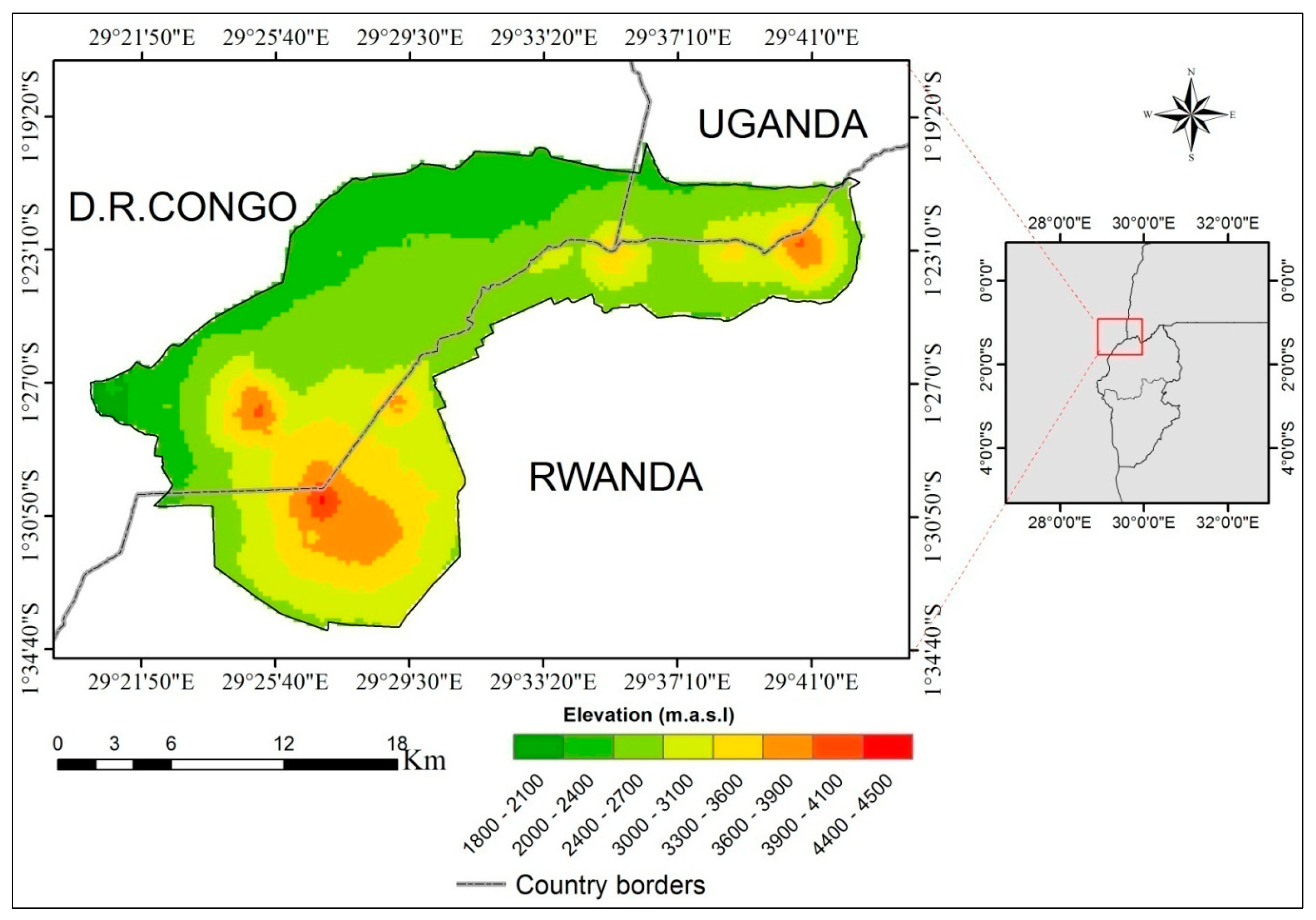
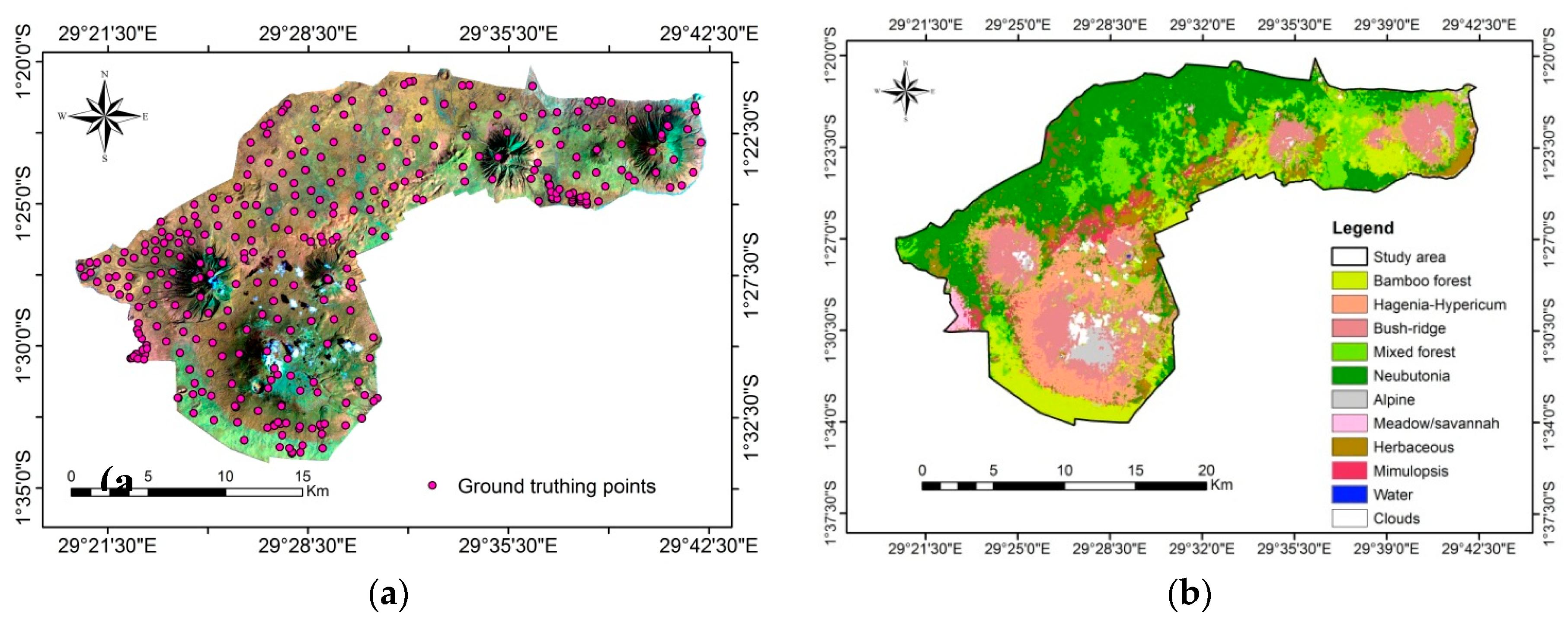
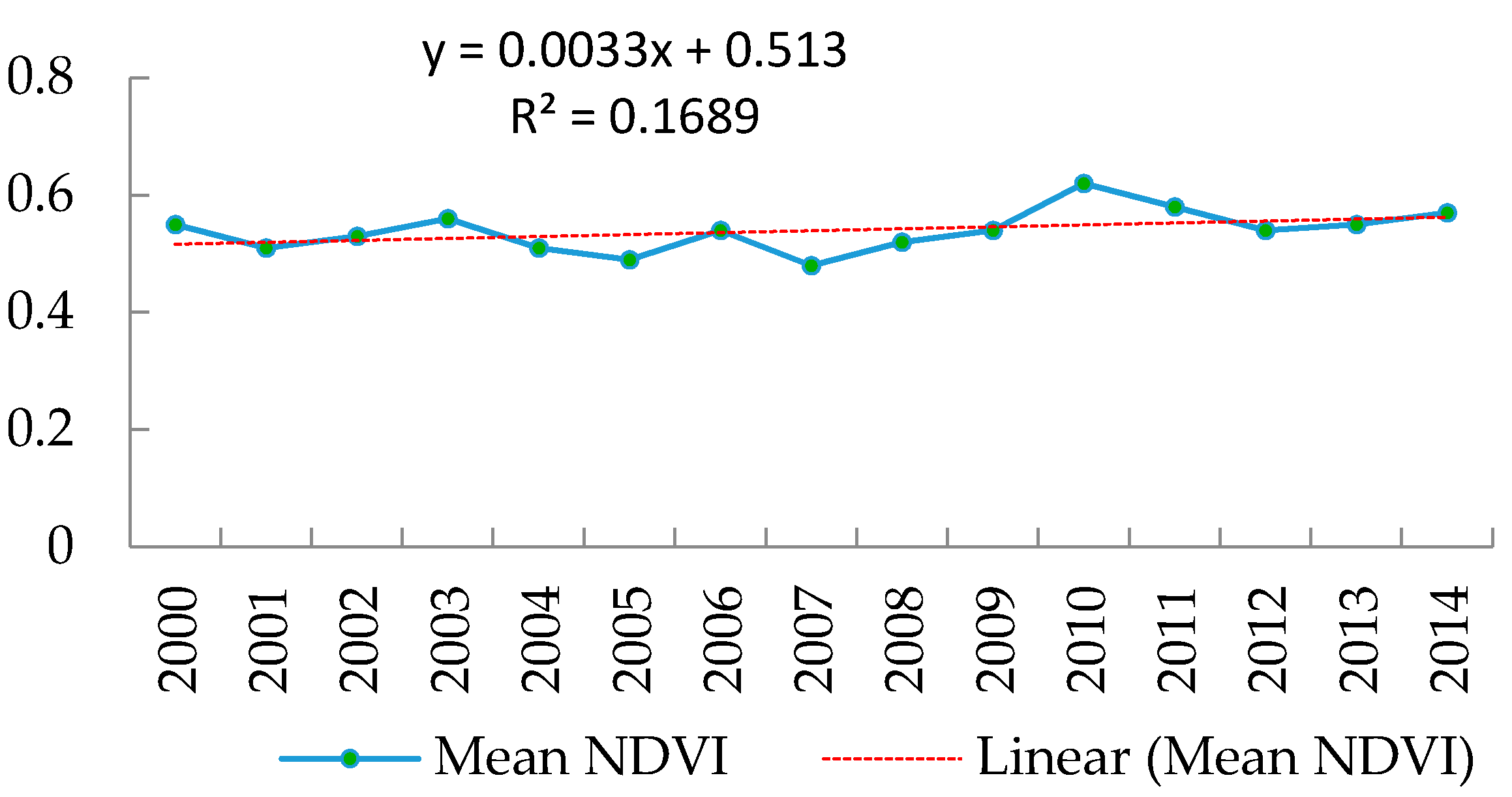
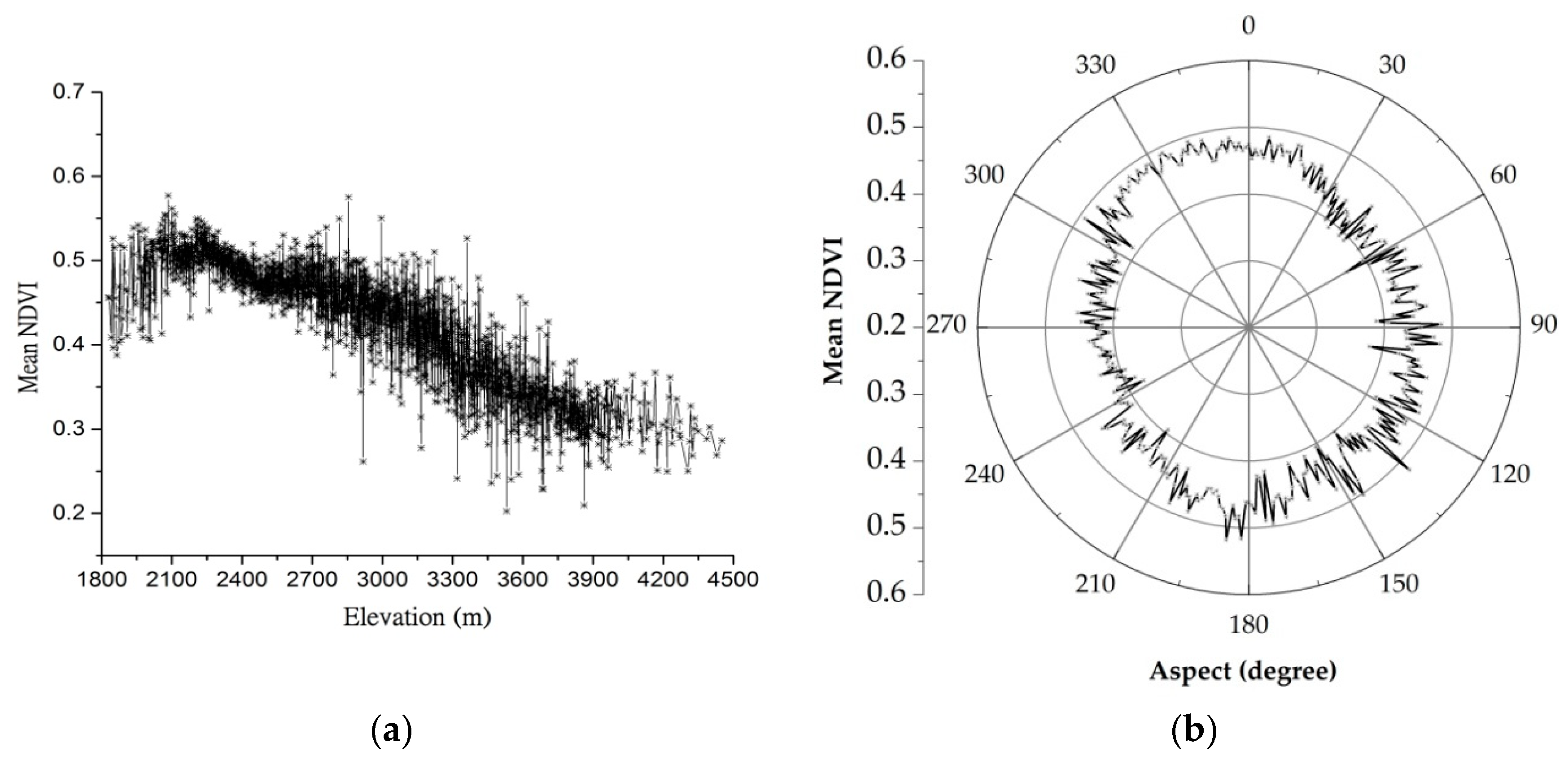


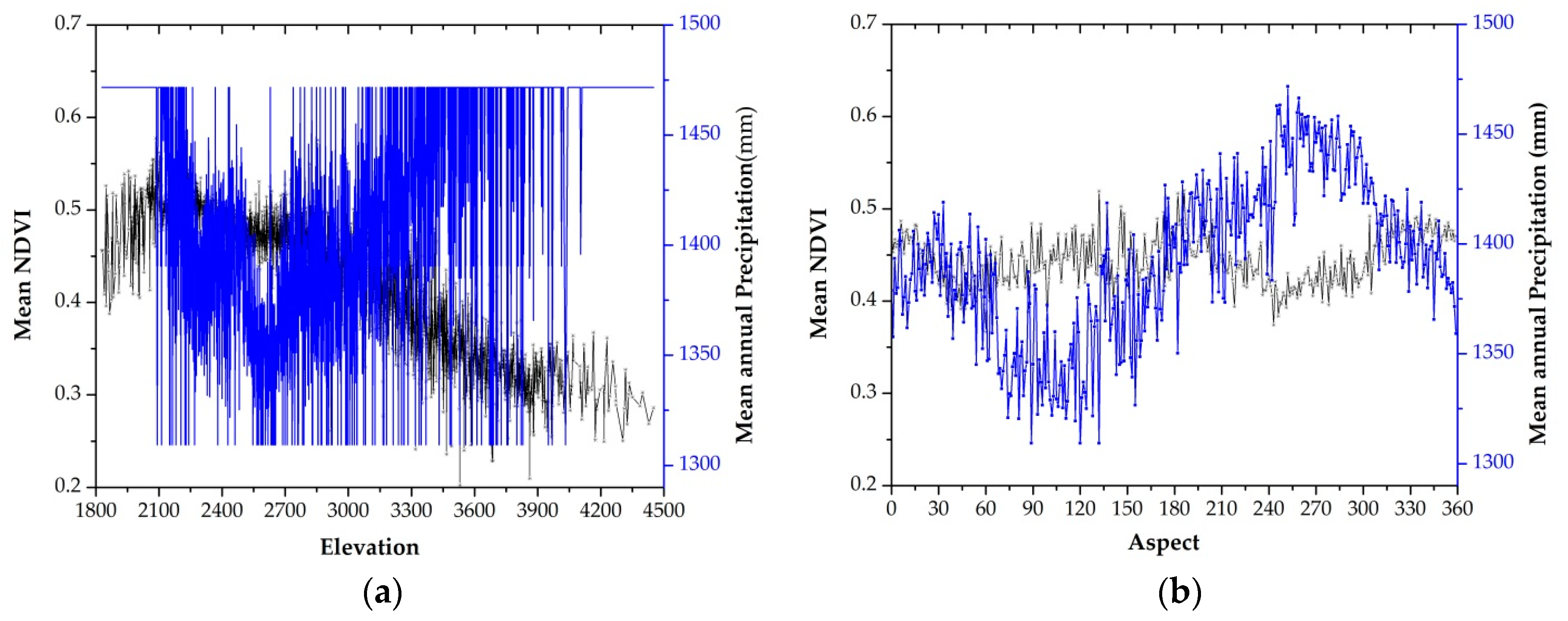

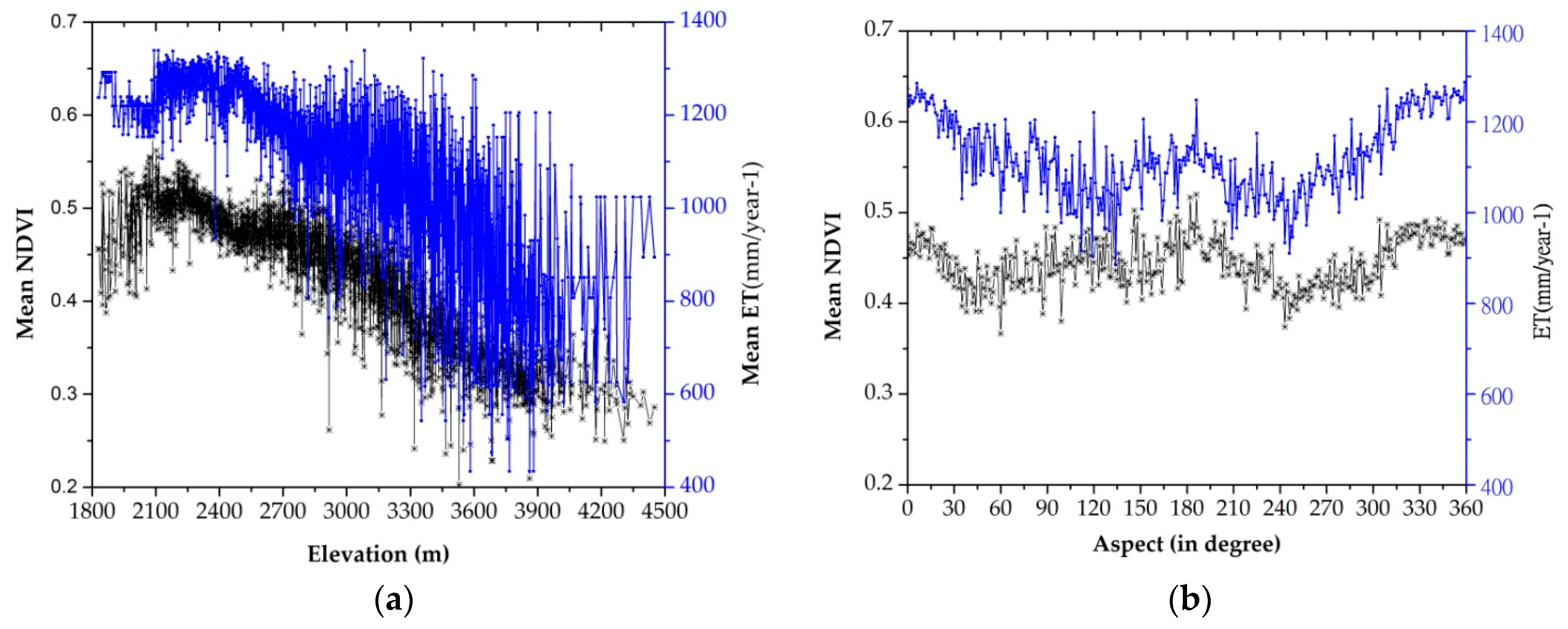
| Climate Factors | Topography | Vegetation Indices (VIs) |
|---|---|---|
| Precipitation (Rainfall) | Aspect calculated from DEM | Normalized Difference Vegetation- |
| Land Surface Temperature | Elevation | Index (NDVI) |
| Evapotranspiration | - | - |
| C0 | C1 | C2 | C3 | C4 | C5 | C6 |
|---|---|---|---|---|---|---|
| −0.268 | 1.378 | 0.183 | 54.3 | −2.238 | −129.2 | 16.4 |
| Vegetation Types | % | Area (Sq.km) |
|---|---|---|
| Bamboo Forest | 10.77 | 4894.81 |
| Hagenia-Hypericum | 11.17 | 5075.98 |
| Bush ridge | 14.58 | 6626.79 |
| Mixed forest | 15.52 | 7053.04 |
| Neubutonia | 33.97 | 15,442.10 |
| Alpine | 1.91 | 869.77 |
| Meadow/savannah | 1.08 | 491.14 |
| Herbaceous | 5.15 | 2339.76 |
| Mimulopsis | 3.87 | 1758.71 |
| Veg. Type | NDVI | Na | NE | E | SE | S | SW | W | NW | Nb |
|---|---|---|---|---|---|---|---|---|---|---|
| Bamboo | Mean | 0.51 | 0.48 | 0.45 | 0.44 | 0.47 | 0.43 | 0.45 | 0.52 | 0.52 |
| Std | 0.09 | 0.11 | 0.1 | 0.13 | 0.09 | 0.09 | 0.12 | 0.1 | 0.06 | |
| Alpine | Mean | 0.33 | 0.32 | 0.32 | 0.29 | 0.29 | 0.25 | 0.23 | 0.3 | 0.35 |
| Std | 0.11 | 0.11 | 0.12 | 0.11 | 0.11 | 0.08 | 0.08 | 0.06 | 0.15 | |
| Bush-Ridge | Mean | 0.41 | 0.38 | 0.37 | 0.35 | 0.34 | 0.35 | 0.39 | 0.42 | 0.37 |
| Std | 0.16 | 0.16 | 0.14 | 0.17 | 0.1 | 0.15 | 0.18 | 0.15 | 0.17 | |
| Hagenia | Mean | 0.49 | 0.44 | 0.43 | 0.41 | 0.41 | 0.44 | 0.49 | 0.53 | 0.54 |
| Std | 0.09 | 0.12 | 0.1 | 0.13 | 0.07 | 0.11 | 0.11 | 0.1 | 0.1 | |
| Herbaceous | Mean | 0.57 | 0.52 | 0.49 | 0.51 | 0.48 | 0.51 | 0.54 | 0.59 | 0.58 |
| Std | 0.09 | 0.08 | 0.1 | 0.1 | 0.07 | 0.08 | 0.14 | 0.07 | 0.06 | |
| Meadow | Mean | none | none | 0.48 | 0.5 | 0.6 | 0.37 | 0.55 | 0.55 | 0.53 |
| Std | none | none | 0.04 | 0.08 | 0 | 0.05 | 0.08 | 0.08 | 0.05 | |
| Mimulopsis | Mean | 0.59 | 0.54 | 0.42 | 0.44 | 0.43 | 0.43 | 0.56 | 0.58 | 0.58 |
| Std | 0.07 | 0.07 | 0.13 | 0.09 | 0.05 | 0.1 | 0.09 | 0.08 | 0.07 | |
| Mixed-forest | Mean | 0.49 | 0.46 | 0.42 | 0.42 | 0.43 | 0.44 | 0.47 | 0.49 | 0.50 |
| Std | 0.07 | 0.11 | 0.12 | 0.13 | 0.11 | 0.11 | 0.1 | 0.08 | 0.07 | |
| Neubutonia | Mean | 0.56 | 0.54 | 0.49 | 0.46 | 0.5 | 0.48 | 0.53 | 0.58 | 0.57 |
| Std | 0.06 | 0.09 | 0.1 | 0.08 | 0.11 | 0.13 | 0.15 | 0.07 | 0.06 |
© 2017 by the authors. Licensee MDPI, Basel, Switzerland. This article is an open access article distributed under the terms and conditions of the Creative Commons Attribution (CC BY) license ( http://creativecommons.org/licenses/by/4.0/).
Share and Cite
Kayiranga, A.; Ndayisaba, F.; Nahayo, L.; Karamage, F.; Nsengiyumva, J.B.; Mupenzi, C.; Nyesheja, E.M. Analysis of Climate and Topography Impacts on the Spatial Distribution of Vegetation in the Virunga Volcanoes Massif of East-Central Africa. Geosciences 2017, 7, 17. https://doi.org/10.3390/geosciences7010017
Kayiranga A, Ndayisaba F, Nahayo L, Karamage F, Nsengiyumva JB, Mupenzi C, Nyesheja EM. Analysis of Climate and Topography Impacts on the Spatial Distribution of Vegetation in the Virunga Volcanoes Massif of East-Central Africa. Geosciences. 2017; 7(1):17. https://doi.org/10.3390/geosciences7010017
Chicago/Turabian StyleKayiranga, Alphonse, Felix Ndayisaba, Lamek Nahayo, Fidele Karamage, Jean Baptiste Nsengiyumva, Christophe Mupenzi, and Enan Muhire Nyesheja. 2017. "Analysis of Climate and Topography Impacts on the Spatial Distribution of Vegetation in the Virunga Volcanoes Massif of East-Central Africa" Geosciences 7, no. 1: 17. https://doi.org/10.3390/geosciences7010017






